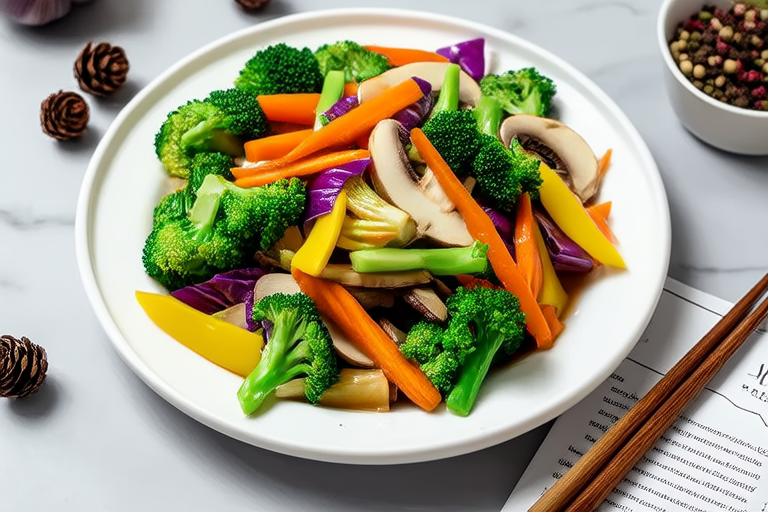Vegetable Stir-Fry Symphony: A Rainbow of Flavors
Welcome to the Vegetable Stir-Fry Symphony
Welcome to the world of Vegetable Stir-Fry Symphony, a culinary masterpiece that celebrates the vibrant colors and diverse flavors of fresh vegetables. In this recipe, we will explore the art of stir-frying, an essential cooking technique that originated in Chinese cuisine but has since become popular worldwide. Stir-frying is not only quick and efficient but also allows for maximum flavor retention and nutrient preservation.
In this symphony of flavors, each vegetable plays a unique role, contributing its own color, texture, and taste to create a harmonious dish. From crisp bell peppers to tender snow peas, each ingredient adds a new layer of complexity to the final dish. The key to success lies in the careful selection of vegetables, the right balance of seasonings, and precise cooking techniques.
This recipe is designed for both seasoned chefs and beginners alike. It offers step-by-step instructions, along with tips and tricks to ensure your stir-fry is nothing short of a culinary masterpiece. Let’s dive into the ingredients and methods that will transform your kitchen into a bustling culinary stage.
The Ingredients: A Symphony of Colors
To create a visually stunning and flavorful vegetable stir-fry, it’s important to select a variety of vegetables that offer different textures and colors. Here’s a list of ingredients that will form the backbone of our symphony:
- Bell Peppers: Choose a mix of red, yellow, and green bell peppers for a colorful contrast. These peppers add sweetness and a slight crunch to the dish.
- Zucchini: This mild-flavored summer squash provides a delicate texture and a touch of earthiness.
- Snap Peas: These crunchy pods add a refreshing bite and a pop of green to the dish.
- Bok Choy: With its tender stems and slightly bitter leaves, bok choy brings a unique flavor profile to the stir-fry.
- Carrots: Thinly sliced carrots provide a sweet and slightly crunchy element, as well as a vibrant orange hue.
- Mushrooms: Button or shiitake mushrooms add depth and umami to the dish, complementing the other vegetables.
- Garlic and Ginger: These aromatic ingredients enhance the overall flavor profile, adding warmth and complexity.
- Scallions: Finely chopped scallions provide a fresh, mild onion flavor and a garnish of green.
- Olive Oil or Sesame Oil: For added richness and flavor, use high-quality oils.
- Seasonings: Soy sauce, oyster sauce, rice vinegar, and a pinch of sugar will bring out the best in your vegetables.
Each ingredient contributes to the visual appeal and taste of the dish, creating a harmonious blend of flavors that dance on your palate. The key is to use fresh, seasonal produce whenever possible to ensure the highest quality and flavor.
Preparing the Vegetables: A Prelude to Flavor
Before you start cooking, it’s crucial to prepare your vegetables properly. Proper preparation ensures even cooking and optimal flavor extraction. Follow these steps to prepare your ingredients:
1. Clean and Trim
Begin by washing all the vegetables thoroughly under cold running water. Remove any damaged parts or tough stems. Trim the ends of the zucchini and snap peas, and slice the bell peppers into thin strips. Cut the bok choy into bite-sized pieces, separating the stems from the leaves.
2. Slice and Dice
For uniform cooking, slice the vegetables into similar-sized pieces. This ensures that all ingredients cook evenly and prevent some from becoming overcooked while others remain raw. Slice the carrots thinly, julienne the zucchini, and cut the mushrooms into quarters or halves.
3. Marinate (Optional)
If you want to enhance the flavor of your vegetables, consider marinating them briefly before cooking. Mix a small amount of soy sauce, sesame oil, and rice vinegar in a bowl. Add the sliced vegetables and let them sit for about 10 minutes. This step is optional but can add an extra layer of flavor to your stir-fry.
4. Prepare Garlic and Ginger
Minced garlic and ginger are essential for adding depth and warmth to the dish. Use a microplane grater or finely chop them to release their full flavor potential.
The Cooking Process: A Rhythmic Dance
Now that your vegetables are prepared, it’s time to bring them together in a harmonious dance of flavors. The key to a successful stir-fry lies in the timing and precision of each step. Follow these steps carefully to achieve the perfect balance of textures and flavors:
1. Heat the Wok or Pan
Heat a large wok or skillet over high heat. Once the pan is hot, add a tablespoon of olive oil or sesame oil. Swirl the oil around to coat the entire surface of the pan. This ensures that the vegetables won’t stick and will cook evenly.
2. Sauté Garlic and Ginger
Add the minced garlic and ginger to the hot oil. Stir-fry for about 30 seconds until fragrant. Be careful not to burn the garlic, as this can make the dish bitter. The aroma of the garlic and ginger should fill your kitchen, signaling the start of a flavorful journey.
3. Cook the Firm Vegetables
Start with the vegetables that take the longest to cook. In this case, add the bell peppers and carrots first. Stir-fry for about 2-3 minutes, or until they begin to soften but still retain their crunch. This initial cooking step helps set the foundation for the rest of the dish.
4. Add the Tender Vegetables
Next, add the zucchini, snap peas, and mushrooms. Stir-fry for another 2-3 minutes, ensuring that all the vegetables are coated in the oil and evenly distributed. At this point, the vegetables should be just starting to wilt, but still have a vibrant color and crisp texture.
5. Incorporate Bok Choy
Add the bok choy to the wok. Stir-fry for about 1 minute, just until the leaves are wilted and the stems are tender. Overcooking bok choy can cause it to become mushy, so it’s important to remove it from the heat at the right moment.
6. Season the Dish
Now it’s time to add the seasonings. Pour in a tablespoon of soy sauce, a teaspoon of oyster sauce, and a splash of rice vinegar. Stir everything together to ensure the vegetables are evenly coated. If desired, add a pinch of sugar to balance the flavors.
7. Garnish and Serve
Remove the stir-fry from the heat and transfer it to a serving plate. Garnish with finely chopped scallions for a pop of green and freshness. Serve immediately while the vegetables are still crisp and vibrant.
Tips and Tricks for Perfect Stir-Frying
Stir-frying may seem simple, but there are several tips and tricks that can elevate your dish to new heights. Here are some expert tips to ensure your vegetable stir-fry is nothing short of perfection:
1. Use High Heat
Stir-frying requires high heat to sear the vegetables quickly and lock in their moisture and nutrients. Make sure your wok or skillet is very hot before adding the oil and vegetables. This prevents the vegetables from stewing and losing their crispness.
2. Don’t Overcrowd the Pan
Adding too many vegetables at once can lower the temperature of the pan, resulting in soggy, unevenly cooked vegetables. Instead, cook the vegetables in batches if necessary, or use a larger pan to accommodate them all at once.
3. Stir Constantly
Stirring frequently ensures that the vegetables cook evenly and don’t stick to the bottom of the pan. Use a spatula to toss the vegetables continuously throughout the cooking process.
4. Use Fresh Ingredients
The quality of your vegetables directly impacts the flavor and texture of the final dish. Always use fresh, seasonal produce for the best results. Avoid using pre-cut or frozen vegetables, as they tend to lack the vibrant colors and fresh flavors of their fresh counterparts.
5. Balance Sweet, Sour, Salty, and Umami
A well-balanced stir-fry should have a harmonious blend of flavors. Adjust the seasoning according to your taste preferences, but aim for a balance of sweet (from carrots), sour (from rice vinegar), salty (from soy sauce), and umami (from mushrooms and oyster sauce).
Variations and Pairings: Expanding the Symphony
The beauty of a vegetable stir-fry lies in its versatility. You can easily adapt this recipe to suit your preferences or dietary restrictions. Here are some variations and pairing suggestions to inspire you:
1. Protein Additions
For a more substantial meal, consider adding protein to your stir-fry. Tofu, tempeh, shrimp, or chicken can all be incorporated into the dish. Simply sauté the protein separately before adding it to the vegetables.
2. Grain or Noodle Accompaniments
Serve your stir-fry over a bed of rice, quinoa, or noodles for a complete meal. Steamed jasmine rice pairs beautifully with the flavors of this dish, while soba noodles add a chewy texture.
3. Spicy Variations
If you enjoy a bit of heat, add a tablespoon of chili paste or a few dashes of sriracha to the stir-fry. For an extra kick, include some red chili flakes or thinly sliced fresh chili peppers.
4. Herb and Spice Infusions
Enhance the dish with fresh herbs like cilantro, basil, or Thai basil. A sprinkle of sesame seeds or a drizzle of toasted sesame oil can also add a nutty flavor and aroma.
Conclusion: Embrace the Symphony
As you savor each bite of your Vegetable Stir-Fry Symphony, take a moment to appreciate the harmony of flavors and textures that come together in this dish. Each vegetable contributes its own unique character, creating a symphony on your plate. Whether you’re hosting a dinner party or simply enjoying a home-cooked meal, this dish is sure to delight your senses and satisfy your appetite.
With practice and experimentation, you can continue to refine your stir-frying skills and explore new combinations of vegetables and seasonings. The possibilities are endless, and the joy of cooking is in the journey. So, roll up your sleeves, grab your wok, and let the culinary symphony begin!


